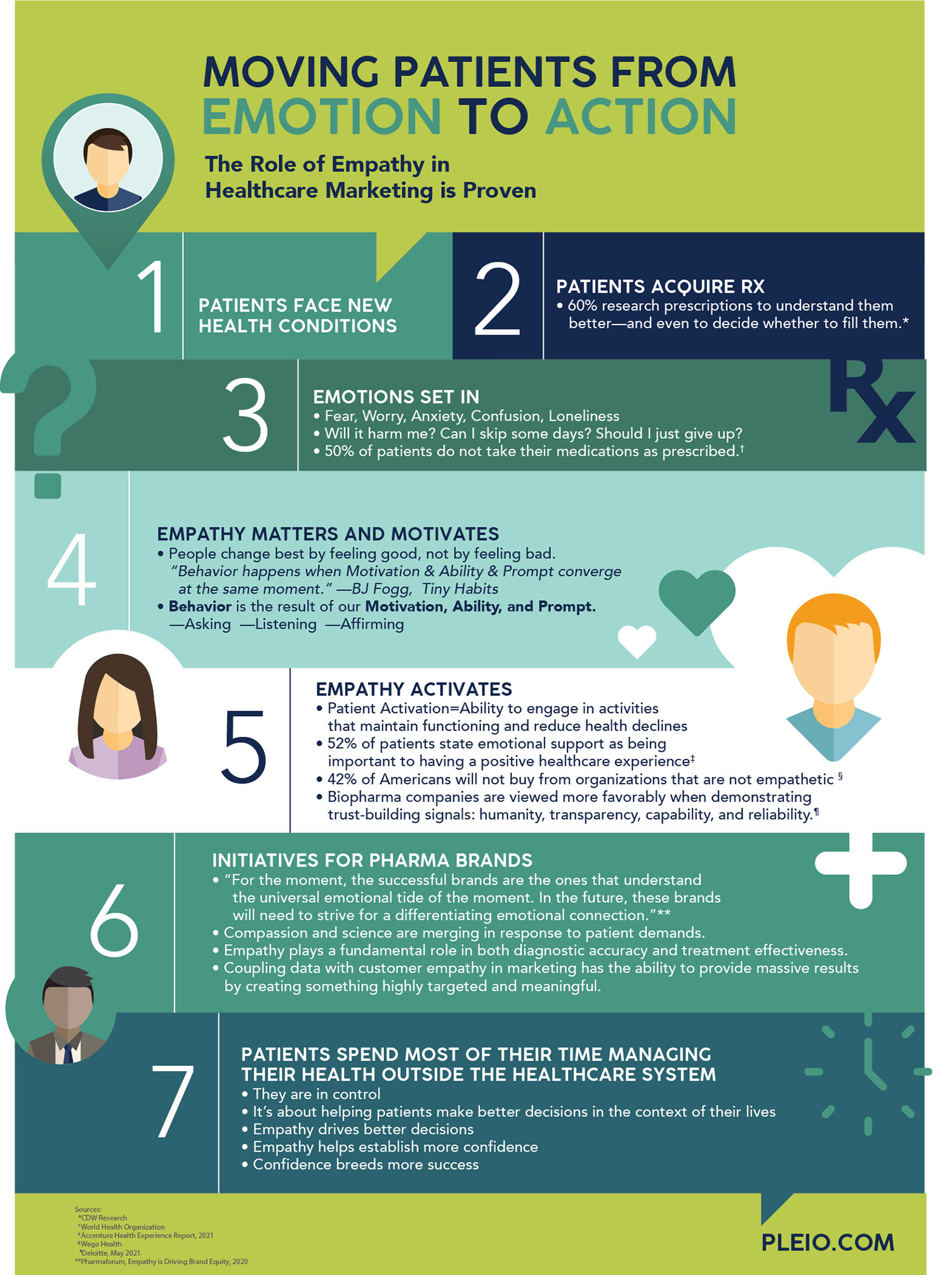Marketing is in a golden era of innovation and transformation, rapidly creating better healthcare solutions for the entire industry and all its key stakeholders. In particular, an intense focus on patients through greater data, smarter analytics, more targeted media, and more personalized connections has led to amazing and innovative opportunities. From patients to HCPs to pharma clinical trials, there is a feeding frenzy on new (and untested) solutions that in 2021 alone amounted to $29 billion of investments in new healthcare endeavors and ideas.
Still, the rush to build new platforms, AI, data, etc., are predominantly focused on technology as the solution for all patient-related issues, seemingly leaving the emotional state of the patient behind. Any behavioral expert or psychologist will tell you that technology only gets you so far. The state of the patient’s emotional mindset is a quality measure that is increasing in importance across every aspect of healthcare.
As industry experts, we need to ask the question: Are we bold enough to scratch beneath the surface? Is a potentially one-dimensional technology solution the most effective path to connect and influence patients?
Patients are humans, and humans are emotional beings. For patients to positively manage their medications and health conditions, there is a complex interplay of emotion and cognition. Traditional medical care is rooted in taking a logical and practical approach; often the doctor has so little time that they have to focus on the practical. But emotions complete the full spectrum of the patient experience and can include pain, joy, anxiety, unhappiness, hope, loss, anger, and a gamut more. Patient emotions play a broader and integral role going far past clinical decision making.
Emotional Intelligence (EQ) can help pharma brands deliver better service while achieving superior outcomes. Brand marketers should harness the power of EQ through rigorous training and a patient-centered mindset. Delivering patient-centered experiences starts with understanding who the patient is and what their emotional mindset is at the critical points of influence.
Empathy, Your Time Has Come
Empathy opens all doors, and is one of our most primal instincts, yet it’s so personal, so individual, so authentic, that marketers shy away from it because it feels too difficult to implement and measure. Instead, they turn to the noise of technology’s excitement and promise rather than the age-old common sense that listening to a patient’s needs is greater than getting that email to them at the right moment.
“Being heard” has been documented as the number one need patients have, yet the seminal move of the pharma industry towards customer centricity does not address it. Empathy is at the heart of the most effective health conversations, as is seen now in the Gen X and Z doctors who are the first generations being trained on it in medical school.
Even the welcome focus on customer experience (CX) is an attempt at addressing customer needs in functional tasks—biosensors, tracking devices, phone apps, scheduling appointments, smart pill bottles, and the like are being adopted because the need is being delivered with much better CX. But that should not be seen as a substitute for the power of the human connection. True customer centricity, true CX, is the art and science of balancing human emotional needs with functional tasks balanced out by a user-centric focus.
Integrating Empathy to Craft the Perfect Patient Journey
To focus on tech as a human solution is a backward strategy. If you build it, they will come has been proven false with the evidence of thousands of abandoned healthcare and pharma apps and patient support programs littering the digital junkyard.
Why? True patient-centric healthcare is not one-dimensional.
Digital alone does not serve the true master: the customer. Nor a true need: how do they feel about the health decisions they have to make? With so many pharma competitors and others using technology as their sole solution, the market has become overcrowded with experiences formed only by the data of zeros and ones, not by the data generated by actions around a patient’s emotions. The Perfect Patient Journey is based on empathy and task—not one or the other. It is a harmonious combination bringing both humanity and digital connections together in a truly meaningful way. The impact of listening, providing a human voice, and offering help at a critical juncture in a personal health journey can be captured and measured.
But how can brand marketers achieve this and advance humanism in healthcare? Here are four tips to apply EQ to your marketing strategies to deliver more patient-centered experiences.
1. Acknowledge Their Emotion
Cleveland Clinic has codified empathy at the heart of their brand, with training, podcasts, and even a Chief Empathy Office (a neurologist). Their goal in putting empathy at the center was to drive a more humanistic approach across the whole organization and to “activate” empathy on a daily basis.
As a global leader in healthcare, they have proven that simply asking “How can I help?” is the most effective means to get past natural defenses and the confusion around healthcare, and thereby providing a better experience for both the patient and the organization who serves them.
We all want meaningful connections, right? What is a more effective way to truly connect with a patient than extending a helping hand and listening ear when they need it the most; a human connection instep with data collection can accomplish this.
2. Understand Their Situation
The true meaning of empathy is putting yourself in another’s shoes to understand where they are. How does that apply in healthcare marketing?
Pharma marketers are tasked with educating patients. Effective patient communication is powerful. It’s associated with higher patient satisfaction and better adherence to medications. Empathy is a critical component of that communication, and has attracted increasing attention.
Empathy creates trust and builds confidence. Confidence is defined as a faith or belief that one will act in a right, proper, or effective way. Confidence breeds belief, and in turn, success. Research such as the Self-Efficacy Theory states that self-efficacy refers to an individual’s belief in his or her capacity to execute behaviors necessary to produce specific performance attainments.
3. Make Patients Feel Good About Their Engagement and Their Treatment
Moving patients from emotion to action is what every pharma marketer seeks, especially in the omni-channel world.
Communicating with patients is a crucial part of the overall patient experience. According to the Agency for Healthcare Research and Quality (AHRQ), improvements in patient experience are linked to improvements in clinical outcomes.
Making individuals feel heard and understood as they wrestle with healthcare and medication decisions, is the first step to trust and building confidence. Trust is the pathway to rational and emotional belief in medication that could improve their health. In other words, patient education is more compelling when the patient is more open to learning. Empathy opens the heart and mind—aligning patient emotions and cognition.
By inserting “the empathy factor” into their patient education efforts, pharma marketers can work towards promoting positive behavior and routine. Utilizing platforms that truly deliver personalized and empathic reinforcements as a complement to their current patient support efforts will yield better brand experiences through a more robust CX and more success for the brand itself.
4. Support Patients Through Time
Increasing patient activation is key for ensuring positive care outcomes and patient self-management.
As an industry, the terms patient engagement and patient activation are often used interchangeably. Patient engagement is an over-used expression that encompasses many aspects of a patient managing through a health condition or medication use. Patient activation determines how a patient is involved in their own health and includes patient education, shared decision-making, and patient outreach. While each of these elements on their own are key patient engagement strategies, taken together, these strategies can help increase patient activation levels for the longer term.
Moving from transactional patient treatment to a deeper, more longitudinal relationship requires interpersonal skills combined with digital technology, which together pave the pathway for the ultimate patient experience.
In the end, the hole in the heart of healthcare is really an amazing opportunity, too.









